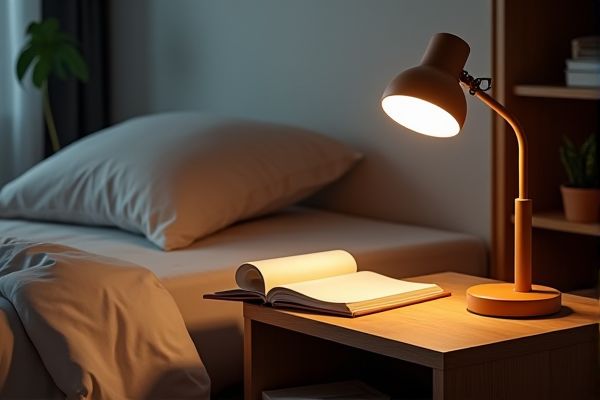
Study lamps provide focused, bright lighting ideal for tasks requiring concentration, while bedside lamps offer softer, ambient light to create a relaxing atmosphere for winding down. Discover how choosing the right lamp can enhance Your space by reading the rest of the article.
Table of Comparison
| Feature | Study Lamp | Bedside Lamp |
|---|---|---|
| Primary Use | Focused lighting for reading, writing, or studying | Ambient or soft lighting for relaxation and bedtime |
| Light Brightness | Bright, adjustable intensity for clear visibility | Dim to medium brightness to create a cozy atmosphere |
| Light Color | Cool white or daylight (4000K-6500K) | Warm white (2700K-3000K) |
| Design | Functional, ergonomic with adjustable arms or heads | Decorative, often matching bedroom decor |
| Placement | Desk or study table | Bedside table or nightstand |
| Power Source | Plug-in or USB powered | Plug-in, battery, or touch sensitive options |
| Additional Features | Adjustable brightness, swivel, magnifier options | Touch control, timers, dimmers, USB charging ports |
| Price Range | Typically $20 - $100 | Typically $15 - $80 |
Introduction to Study Lamps and Bedside Lamps
Study lamps provide focused, adjustable lighting designed to reduce eye strain during tasks like reading or writing, making them essential for productivity and concentration. Bedside lamps offer softer, ambient illumination to create a relaxing atmosphere for winding down before sleep, often featuring dimmable settings for comfort. Choosing the right lamp enhances Your space by balancing task-specific brightness with calming light suitable for rest.
Purpose and Functionality Comparison
Study lamps are designed to provide focused, adjustable lighting that reduces eye strain during reading or detailed tasks, often featuring bright, cool-toned LED bulbs for enhanced concentration. Bedside lamps prioritize ambient, soft light that creates a relaxing atmosphere conducive to winding down and facilitating sleep, frequently incorporating warm-toned bulbs and dimmable settings. The primary functional difference lies in task-oriented illumination versus mood lighting, aligning with users' needs for productivity or relaxation in their respective environments.
Design Differences: Study Lamp vs Bedside Lamp
Study lamps typically feature adjustable arms, focused light beams, and brighter LED bulbs to provide optimal illumination for reading or detailed tasks. Bedside lamps prioritize softer, ambient lighting with decorative designs to create a calming atmosphere conducive to relaxation. Your choice depends on whether you need functional lighting for work or soothing light for winding down.
Light Quality and Brightness Analysis
Study lamps provide focused, high-brightness light with adjustable intensity and color temperature, ideal for tasks requiring concentration and reduced eye strain. Bedside lamps offer softer, warm light that creates a relaxing atmosphere, favoring ambient illumination over intense brightness. Your choice affects visual comfort and productivity, with study lamps promoting alertness and bedside lamps enhancing relaxation.
Ergonomics and Eye Comfort
Study lamps are designed with adjustable brightness and color temperature settings to reduce eye strain during prolonged tasks, featuring angled arms and flexible necks for optimal lighting direction and posture support. Bedside lamps prioritize softer, ambient light that promotes relaxation and minimizes harsh glare, often incorporating warm hues to facilitate winding down before sleep. Ergonomic study lamps emphasize task-focused illumination and customizable positioning, while bedside lamps focus on comfort and creating a soothing nighttime environment.
Energy Efficiency and Bulb Types
Study lamps typically use LED bulbs that offer higher energy efficiency and longer lifespan compared to traditional incandescent bulbs often found in bedside lamps. LED study lamps provide concentrated, bright light ideal for focused tasks while consuming less power, reducing electricity costs. Bedside lamps may use softer, warm-toned bulbs such as CFLs or incandescent, which are less energy-efficient but create a cozy ambiance suitable for relaxation.
Space Utilization and Placement Options
Study lamps are typically designed with adjustable arms and focused light beams to optimize task lighting in compact workspaces, allowing precise placement on desks or shelves without occupying excessive surface area. Bedside lamps often feature a more stationary base and softer light, intended for ambient illumination and easier access from bed, potentially requiring more surface space beside the bed for stable placement. Both types prioritize space utilization differently: study lamps maximize functional lighting efficiency, while bedside lamps balance convenience with aesthetic integration in bedroom layouts.
Style and Aesthetic Appeal
Study lamps typically feature a minimalist design with adjustable arms and focused light, enhancing productivity and complementing modern or industrial decor. Bedside lamps often prioritize softer, ambient lighting with decorative bases and shades, adding warmth and a cozy aesthetic to bedroom interiors. Choosing between the two depends on whether the goal is functional task lighting or creating a relaxing atmosphere.
Cost Considerations and Value
Study lamps typically offer higher brightness and adjustable features suited for focused tasks, often resulting in a slightly higher price compared to bedside lamps designed for ambient lighting and ease of use. Your investment in a study lamp may provide better eye comfort and productivity, making it more valuable for work or study environments. Bedside lamps generally offer affordable options with aesthetic appeal, prioritizing convenience and mood setting over functional lighting intensity.
Choosing the Right Lamp for Your Needs
Study lamps provide focused, bright light ideal for tasks requiring concentration and reduced eye strain, making them perfect for workstations or study areas. Bedside lamps offer softer, ambient lighting suitable for creating a relaxing atmosphere and facilitating night-time reading. Selecting the right lamp depends on your primary activity: opt for a study lamp to enhance productivity or a bedside lamp to promote comfort and relaxation.
 homyna.com
homyna.com